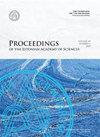Metabolism of copper and possibilities for its regulation
IF 0.7
4区 综合性期刊
Q3 MULTIDISCIPLINARY SCIENCES
引用次数: 0
Abstract
. Copper is an indispensable biometal participating as a redox catalyst in many important biochemical processes. However, if uncontrolled, copper ions induce the formation of reactive oxygen species and become toxic. For this reason, cellular copper metabolism is tightly regulated and specific proteins – copper chaperones – participate in the metalation of cellular copper transporters and enzymes. The thermodynamic background for cellular copper distribution is known, and copper is driven to cellular destinations according to shallow affinity gradients. Copper metabolism is disturbed in the case of Wilson’s, Menkes, and Alzheimer’s disease (AD), characterized by copper overload, deficiency, and misdistribution, respectively. Wilson’s and Menkes disease could be treated by copper chelators and supplements, respectively; however, with AD, a search for effective molecular tools for the correction of copper metabolism is ongoing. One natural copper binding ligand – α lipoic acid – has shown positive results in cellular and fruit fly models of AD and serves as a promising candidate for the regulation of copper metabolism in the case of AD.铜的代谢及其调控的可能性
本文章由计算机程序翻译,如有差异,请以英文原文为准。
求助全文
约1分钟内获得全文
求助全文
来源期刊

Proceedings of the Estonian Academy of Sciences
综合性期刊-综合性期刊
CiteScore
1.80
自引率
22.20%
发文量
24
审稿时长
>12 weeks
期刊介绍:
The Proceedings of the Estonian Academy of Sciences is an international scientific open access journal published by the Estonian Academy of Sciences in collaboration with the University of Tartu, Tallinn University of Technology, Tallinn University, and the Estonian University of Life Sciences.
The journal publishes primary research and review papers in the English language. All articles are provided with short Estonian summaries.
All papers to be published in the journal are peer reviewed internationally.
The journal is open to word-wide scientific community for publications in all fields of science represented at the Estonian Academy of Sciences and having certain connection with our part of the world, North Europe and the Baltic area in particular.
 求助内容:
求助内容: 应助结果提醒方式:
应助结果提醒方式:


